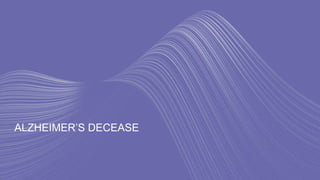
Alzheimer’s.pptx
- 2. Table of content • Alzheimer’s symptoms in my friend’s father • Professor Mason’s lectures reference • Potential Alzheimer’s Decease (AD) mechanisms
- 3. Alzheimer’s symptoms in my friend’s father My friend's father has always been a very active and sharp individual. During the last couple of years, he started showing signs of mental "fogginess": it became difficult for him to concentrate on his favorite grandson stories, he is asking the same questions repeatedly, he is forgetting family events and he is routinely misplacing possessions. Lately he started forgetting his grand children names and became uncapable of staying home alone, even for a short while, due to his unpredictable behavior that have resulted in injury and domestic accidents. He is moody and frustrated most of the time. His relations with grandchildren deteriorated and my friend is in a constant warry for his wellbeing. He was diagnosed with Alzheimer.
- 4. Professor Mason’s lecture reference As the prominent symptoms of the disease, especially in the early stages, seem to be related to the gradually increasing inability to remember recent events, it reminded me of Professor Mason’s lecture on “Memory loss” and made me to suspect that the hippocampus is being gradually damaged. As professor Mason explained, hippocampus is critical for episodic and semantic memories creation, and episodic memories access. This is aligned with the initial symptoms, but when he started forgetting his grandchildren names, semantic memory from few years ago, it made me think that in the later stages, there must be some additional damage to the neocortex. My friend’s father hasn’t reached this step yet, but other Alzheimer’s patients gradually lost bodily functions, ultimately leading to death. This indicates that their autonomous neural systems and motor cortex could have been impaired as well.
- 5. Potential Alzheimer’s Decease (AD) mechanisms Based on https://molecularneurodegeneration.biomedcentral.com/articles/10.1186/s13024-019-0333-5 Macroscopic examination of an AD brain confirms that there are anomalies in the frontal and temporal (including hippocampus) cortices: They often have enlarged sulcal spaces with atrophy of the gyri. There is also atrophy in precuneus, that is also involved in memory tasks, and posterior cingulate gyrus. The AD brain often has at least moderate atrophy in multimodal association cortices, that is connected to conceptual cognitive functions and planning motor actions. Decreased brain weight is observed in most affected individuals. The definitive diagnosis of AD requires microscopic examination, enabling to discover Amyloid plaques and neurofibrillary tangles. Amyloid plaques are mainly composed of beta-amyloid that are fragments of a larger protein. When these fragments cluster together, they appear to have a toxic effect on neurons and to disrupt cell-to-cell communication. Distribution of amyloid plaques: Basal frontal and temporal lobes are affected in Stage A, extension into the association neocortices and hippocampus in Stage B, and finally reaching primary cortices, subcortical nuclei and cerebellum in Stage C.
- 6. Potential Alzheimer’s Decease (AD) mechanisms (continue) In Alzheimer's disease, tau proteins change shape and organize themselves into structures called neurofibrillary tangles (NFT). The mature tangles displace the nucleus and other vital cellular components, and eventually the neurons die. In Stage I neurons of the transentorhinal cortex are first to accumulate the NFTs along with the occasional tangles in the hippocampus and selected nuclei in the basal forebrain and thalamus. In Stage II NFTs observed in Stage I become more robust and the entorhinal cortex, the main interface between the hippocampus and neocortex, becomes involved. In the first two stages NFTs are sparse in the hippocampus proper and virtually absent in the neocortex. In Stage III the transentorhinal and entorhinal cortices are fully involved. NFTs can also be observed in subiculum. Tangles in the basal forebrain and the thalamus also become more pronounced. In Stage IV NFTs corticomedial complex, the basolateral nuclei of the amygdala and some portions of the putamen and accumbens nucleus become impacted. All previous pathology becomes more robust. In Stage V there is extensive involvement of the neocortex. In Stage VI previously affected areas continue to deteriorate and the primary motor cortex becomes impacted.
- 7. Potential Alzheimer’s Decease (AD) mechanisms (continue) Synaptic loss: Cognitive decline and decreases in verbal fluency early in AD are believed to reflect the decreases in synaptic density in the hippocampus and medial temporal lobes. Synaptic loss precedes neuronal loss, and these effects are probably driven by amyloid and tau pathology. Additional pathologic changes observed in AD patients, although their role is unclear: Granulovacuolar degeneration: Abundance of 3–5 μm intraneuronal vacuoles with a central 0.5–1.5 μm dense granule. Those vacuoles accumulate in the hippocampus first, followed by the entorhinal cortex and temporal neocortex and finally the amygdala, thalamus, cingulate gyrus and even association cortices. Hirano bodies: Higher presence of rod-like inclusions, most observed in the hippocampus Inflammatory response: Microglial cells, operating within the brain as phagocytes, become activated and their numbers increase in promotion to neuronal damage associated with NFTs. Reactive astrocytes represent the other inflammatory response observed in the brains of AD patients.